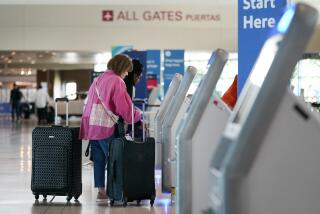No One Really Wins Those Airline Fare Wars
- Share via
The airlines are at it again . . . cutting their own throats.
The latest statistical evidence of their death wish mentality comes from the recently released annual report of the Air Transport Assn.
The report shows that the 30 ATA member airlines carried 10% more passengers in 1985 than in the previous year. Not bad, huh? What’s more, revenues rose by 6.4%.
So profits had to be up, right? Wrong! They were down by a whopping 34%.
How is that possible? Energy costs were down, and stable. Some labor contracts had begun to come into line and millions of dollars were being saved in negotiated productivity agreements with some unions.
How, with those things going for them, in a year in which more people used their services and in which they took in more money at the gate, could profits drop?
What happened? The answer, in two words: fare wars.
Last year was not noted for a high degree of price stability. At different times of the year, deep discounting was the order of the day in California, Hawaii, along the northeastern corridor, to the Pacific Northwest, in the Rocky Mountain states. And none of the airlines ever really wins a fight like that.
It’s easy to look on such battles as the best thing for the traveling public. In a sense, it’s what deregulation is all about.
Really Benefit?
But, in the long run, do we really benefit? A healthy airline industry, providing all of the services and offering all of the reliability we need is in the public’s best interest, in my opinion.
And it’s not going to be that way unless the airlines are healthy.
Perhaps you’re wondering why the airlines keep getting embroiled in these fare wars. It usually starts in one of the two ways.
An airline, new to a specific market and anxious to carve itself a niche quickly, figures the best way to do that is charge less than anybody else. Or sometimes, an established carrier, watching its traffic erode in the face of new competition, will be the first to drop prices.
Fare-cutting usually ends up without an advantage to any airline. No sooner is a low, low, rate introduced by one than it is matched by the others.
So the price differential disappears and, with it, the ability of the airlines to hold on to much of the money they’re taking in. When the yield falls, the bottom line tends to change color from black to red.
The airline community was not, as a whole, in the red in 1985, but it’s sad that, after an encouraging 1984, they let their collective profits drop by more than a third.
There doesn’t seem to be any relief in sight. The airlines still don’t know what to do about fare wars or how to avoid them.
Some of those who start the deep discount downward spiral are those who can least afford it. Sometimes the airlines who match the low fares do so seemingly without a lot of regard for the economic realities of the situation.
Waiting for the Day
I’m waiting for the day when some airline decision maker greets a competitor’s fare gambit with, “Go ahead . . . make my day. You go with those suicide prices but I’m sticking at a level at which I have a chance to make money.”
Then, of course, that executive would have to go out and market his or her airline on the basis of service, quality, comfort, reliability, on-time performance, frequency and neat stuff like that rather than on price. That, I’m afraid, many of them are reluctant to try.
It would be nice to think that the airlines had learned something from the results of 1985. If they did, though, it’s escaped my notice.
Far from being reduced in number and intensity, fare wars are, if anything, more prevalent and the slashes deeper. California is still affected, both intra- and interstate.
And we’re back to the days of $99 transcontinental fares. The heavily traveled eastern corridors between Newark/Washington and Newark/Boston are down to $29 one-way with certain restrictions.
It used to be that you couldn’t find a good $9 fare anywhere. Try Denver/Colorado Springs. How about $25 between Denver and Cheyenne, Wyo.?
What’s happening in the Mile High City is a microcosm of what’s happening, and is liable to happen, in almost any area of the country. The war there is an eyeball-to-eyeball confrontation between People Express-Frontier and Continental Airlines, two low-cost, light-on-frills carriers eager to capture the lion’s share of the Colorado market.
Caught in Middle
Caught in the middle, of course, are United and some others. It’s doubtful if United believes that it can make money on the rates it’s charging in Denver service right now, not with its overhead.
But that’s a fare war for you.
Domestic air transportation usage is probably going to be up again this year. People are staying closer to home because of the Europe/Mideast terror problem.
It’s likely that overall revenues will also rise. But will profitability?
Some airline officials are skeptical. They fear that, a year from now, when the next ATA report is issued, the bottom line will have taken on even more of a reddish hue.
We travelers ought, of course, to take what advantage we can of the current competitive situation in the airline industry. It can’t last forever.
Unfortunately, the end will come not necessarily when the carriers get smart, only when enough of them have committed corporate suicide charging into battles they can’t win.
More to Read
Inside the business of entertainment
The Wide Shot brings you news, analysis and insights on everything from streaming wars to production — and what it all means for the future.
You may occasionally receive promotional content from the Los Angeles Times.










